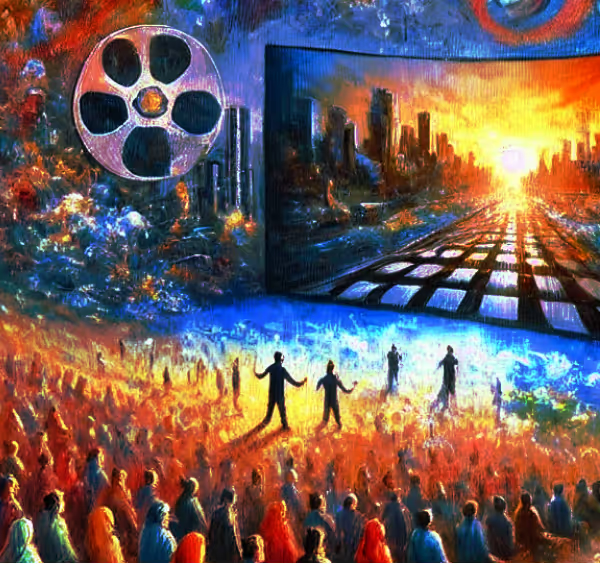Act 1, Act 2, Act 3
These are the three parts of a film: beginning/set up (Act 1), middle/conflict (Act 2), and end/resolution (Act 3).
Example : A boy dreams big (ACT 1), fails many times (ACT 2), and finally succeeds (ACT 3).
Action Line
This line describes what the audience will see on screen. It explains movement, expressions, and settings.
Example : "The boy runs through the crowded street, dodging people and leaping over boxes."
Antagonist
The one who causes problems for the hero.
Example : In Sholay, Gabbar Singh is the villain (antagonist).
Beat
A beat captures how a scene forwards the storyline. mnf.ai recommends that one scene is generated on one beat.
Example : A poor mother shares the news of her son becoming the IAS in the village and the village Thakur doesn't believe it.
Character Sketch
A short description of a character's age, looks, background, habits, etc.
Example : "Ravi, 35, taxi driver, lives alone, sings in traffic, dreams of acting."
Character Types
Different characters in a story : hero, villain, comic, mentor, friend, etc.
Example : In most films, there is a good guy, a bad guy, and people who help or stop them.
Character’s Journey
The ups and downs a character faces while chasing their goal.
Example : A girl from a village wants to be a doctor and faces poverty, rejection, and doubt —
this is her journey.
Character’s Want
This is what the character desires or aims to get.
Example : A poor boy wants to become a cricket player — that want drives the story.
Co-Star
Important supporting characters who help the hero.
Example : In Dangal, the daughters are the co-star to the father.
Dialogue
Dialogue is what the characters say in the film. It moves the story forward and shows emotion.
Example : "I'll never forgive you!" is a strong dialogue that tells us someone is hurt or angry.
Elevator Pitch
An elevator pitch is a quick way to tell your story idea.
Example : Your meet a producer in an elevator — you explain your whole movie idea before the elevator reaches the top floor.
Flashback
A flashback takes us back in time to show something that happened earlier in the character's life which has a bearing in the present.
Example : A soldier remembers his childhood while sitting in a war camp.
Frame
What the camera captures in one image.
Example : A photo of just someone's face or a wide photo showing an entire room — each is a frame.
Genre & Sub Genre
Genre is the type of story (like comedy, drama) and sub-genre is a smaller category within it.
Example : Horror is a genre. Ghost comedy is a sub-genre.
Logline
A logline is one sentence that quickly describes your entire story. It includes the main character, their goal, and the challenge.
Example : A blind girl fights to become a police officer in a corrupt system.
Midpoint
This is the middle of ths story where something big changes.
Example : A kind man learns his best friend betrayed him — everything changes from this point onward.
Montages
A montage is a quick series of short scenes showing time passing or progress.
Example : A student studying, taking exams, graduating — all in a few seconds — shows her journey without losing too much time.
Narrative Structure
The way a story is told — from start to end, or using flashbacks, or different timelines.
Example : Some films move straight, others jump back and forth.
Narrator
The person who tells the story to the audience.
Example : In Taare Zameen Par, Aamir Khan's voice guides us through Ishaan's the story.
Off-Screen (O.S.)
Off-Screen means the person talking is in the scene but not seen in the frame.
Example : A mother speaks from the kitchen, but the camera shows her child in the living room.
One Pager
A one-pager is a single-page document explaining the films idea clearly — what the story is, who it is about, and what happens.
Example : Think of it as explaining a movie to a friend who asks, "What is it about?"
Parenthetical
These are small instruction written in brackets under a character's name to show how the dialogue should be spoken.
Example : (angrily) or (laughing) helps the actor understand the mood.
PBS (Plot, Background, Structure)
PBS is short for the plot (storyline), background (setting), and structure (the way the story is told).
Example : A love story set in wartime India is the background, the couple's struggle is the plot, and the structure is how it's shown.
#PBS STARTS and #PBS ENDS are often used for Montage progression with a Play Back Song.
Pitchdeck
A document or presentation with images, story idea, characters, and tone to show investors.
Example : Like a marriage bio - data showing all details, but for a movie.
Plot & Subplots
The plot is the main story. Subplots are smaller side stories that support it.
Example : A man searches for his lost son (plot), while his wife deals with illness (subplot).
Premise
The premise is a hypothetical situation in which the movie gets created.
Essentially its an Idea.
Example : What if a poor man pretends to be rich to win a girl's heart?
Protagonist
The main character of the story — the one we cheer for.
Example : In Lagaan, Bhuvan is the protagonist who leads the villagers.
Scene
A part of the story happening in one place and time.
Example : Two people fighting at a wedding is one scene. If it moves to a hospital, it's a new scene.
Screenplay
The written version of the movie includes everything: scenes, dialogues, actions, settings.
Example : Like a recipe that tells exactly how to make a dish, the screenplay guides the film.
Screenplay Flow
The sequence in which the scenes are shown to the audience. Script pad gives a distinct title to each scene and facilitates rearranging the scenes by drag and drop for finalizing the narrative structure.
Example : Like water flowing in a river — if it's smooth, the film feels natural.
Script Audit
Checking the script carefully to make sure everything needed for filming is there.
Example : Like checking all items before cooking a big meal.
Script Elements
These are the different parts of a script like Slugline, Action Line, Speaker, Parenthetical, Diaglogue, Transition etc.
Example : Like cooking needs ingredients, a script needs these elements to work — without them, the film would be confusing.
Script Format
This is the proper way of writing a screenplay using the correct layout, indent, spacing, and style.
Example : Just like a formal letter must follow rules, a script must follow format so everyone — actors, directors, crew — can read it easily.
Script Locking
Once the script is final and approved, it's locked — no changes allowed after this point.
Example : Like sealing an envelope — you can't add or remove anything after sealing.
Script Stall
An mnf.ai platform where scripts can be displayed and purchased.
Example : A producer visiting the Script Stall evaluates 20 scripts in an hour and shortlists which 3 to consider buying.
Setup, Conflict, Resolution
This shows how a story starts, what problem arises, and how it is solved.
Example : A girl wants to dance (setup), her leg breaks (conflict), she trains harder
and performs (resolution).
Shot
A single, continuous piece of filming without a cut.
Example : Camera rolls as a man walks into a room, sits and lights a cigarette — this is one shot.
Slugline
A slugline tells where and when a scene happens. It starts with INT. (inside) or EXT. (outside), then the location and time.
Example : "EXT. PARK - EVENING". This tells the reader it's outside, in a park, at evening time.
Speaker
This is the name of the character who is talking. It is written above the dialogue.
Example : If a line is said by "Shyam", then SHYAM is written above his words.
Story Arc
This is the full journey of the story — from beginning, to the middle conflict, to the end.
Example : A thief becomes a hero after facing challenges — his life changes, which is his arc.
Transition
These words tell how one scene changes to another, like "CUT TO:" or "FADE OUT."
Example : It's like flipping a page in a book — these terms move the film forward smoothly.
Treatment Notes
It's a prose summary that provides a richer understanding of the scene's action, characters, setting, tone, and visual style then a basic outline. mnf.ai treatment notes also facilitate voice notes, visual references etc.
Example : Like a doctor's early notes before writing a full report.
V.O. (Voice Over)
Voice Over means the person talking is not present in the scene.
Example : The film starts with an old man's voice, telling his childhood story while showing his village.




.webp)
.webp)
.webp)

.png)


.png)


